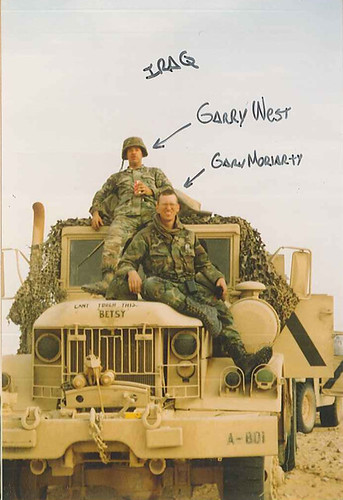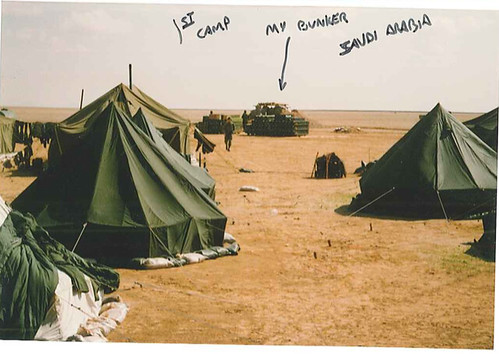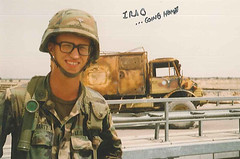Story By: Spc Matthew Dornbusch, 1204th Aviation Support Battalion Unit Public Affairs Historian Representative
Photos by Sgt. 1st Class Gary Moriarty, 1204th Aviation Support Battalion
Click here for more photos on the story.
NOTE: Each week kentuckyguard.com publishes stories by Kentucky National Guard unit public affairs historian representatives, also known as UPAHRs. This is an additional duty taken on by a Soldier or Airmen with the intent of telling their unit’s story. This is one such story ….
[caption id="" align="alignleft" width="309" caption="Spc. Gary Moriarty and battle buddy more than 20 years ago during Operation Desert Storm. Moriarty is now a sergeant first class with the Kentucky Army National Guard's 1204th Aviation Support Battalion deployed as part of Operation New Dawn."]
 Iraq –
Iraq – Operation Desert Storm, commonly referred to as the Gulf War, or now the First Gulf War, officially began January 17
th 1991. Its preparation was quick; a few months prior Soldiers were trained and mobilized, ready to help liberate the small nation of Kuwait. At 3 A.M on that January morning, the U.S. led attack on Saddam’s forces began with its air campaign. Thirty-eight days later on February 24
th, ground forces moved into Kuwait and liberated Kuwait City in only three days. It would only be a few weeks later that coalition forces moved into Iraq and an official cease fire was reached.
With the shadow of the current operations in Iraq, Operation Desert Storm is hardly talked about any longer. Most of the younger Soldiers hardly even know the events that lead up to the conflict, let alone what happened in the conflict itself. Maybe it was because it ended so quick, or maybe because the casualty rate was so low. Whatever the reasons, there is a small group of the Soldiers within Headquarters Company, 1204
th Aviation Support Battalion who have not forgotten. These Kentucky Army National Guard Soldiers, twenty years after their deployment and return home from the First Gulf War, are once again in the Middle East. Their legacy was as the first soldiers in, and now, twenty years later, they will be potentially the last ones out.
Sgt. 1
st Class Dean Regester was stationed at Ft. Knox, Kentucky in 1990 when he was mobilized for Operation Desert Storm. He deployed overseas with the 19
th Engineers as a lightweight vehicle mechanic. Regester compared what he did then with what route clearance teams do now.
“Back then there were no roads,” he said. “The engineers I was with made the roads.”
[caption id="" align="alignright" width="365" caption=""FOB? We didn't have FOBs!" Ground forces during the Persian Gulf War were always on the move, negating the need for fixed installations."]

Sgt. 1
st Class Stephen Leasgang was only nineteen when his unit, 4-8 CAV with the 3
rd Armored Division, was called into action. He departed from Germany where he was stationed, moved through Saudi Arabia and into Iraq. With the MOS 19K -- a M1 Abrams Tank Operator -- Leasgang has already been redeployed to the Middle East and compared the two wars.
“FOBs?” he said, referring to “forward operating bases. “We didn’t have FOBs. The only thing we had then were assembly areas for vehicles. That’s where we slept.”
2
nd Lt. Greg Slater was a twenty year old specialist when he entered theater during Operation Desert Shield. He was with the 2
nd Armored Cavalry Regiment, a rapid deployment unit. They could be deployed to any part of the world in a very short amount of time. Slater was a crew chief at the time.
[caption id="" align="alignleft" width="360" caption="Improvise, adapt and overcome: Long before the advent of 3D digital video games and Facebook, troops during the Persian Gulf War had to come up with their own entertainment."]

"I’ll never forget when we crossed the berm into Iraq and a Blackhawk flew overhead. He dropped his flares and fired his rockets.”
Sgt. 1
st Class Kevin Ireland was also a specialist with the 2
nd ACR back in 1990. Prior to then he spent four years in Germany as a high frequency radio operator.
When asked about his most memorable moment Ireland immediately laughed and said, “March 2, 1991. We were taking sniper fire from a quarry. I was going on almost four days of no sleep when my captain jumped into the hole I had dug to tell me my son had been born. I was so excited I forgot about the sniper fire and started running around telling everyone about my son.”
Staff Sgt. Kelly Darland had just finished special forces selection, but was still formally with the 101
st Pathfinders. He was pulled, however, to go with the 5
th Group Special Forces team. He was put on Personal Security Detail and assigned to guard the officer in charge of the security force that personally watched over the prince of Kuwait.
Sgt. Larry Watkins was a Petty Officer 3
rd Class with the United States Navy serving aboard the U.S.S. America. He was in the Red Sea when his ship was ordered to move off the coast of Kuwait. Watkins worked with aviation ordnance and loaded bombs onto aircraft. This was an around the clock operation and helped the United States keep air superiority over Iraq.
Sgt. John Amburgey was a lance corporal with 2
nd Marine Division 2
nd Amphibious Assault Vehicle Battalion in Alpha Company. He was stationed at Courthouse Bay located within Camp Lejeune, North Carolina.
“We were already to go on a NATO float to Europe,” said Amburgey. “The next morning Cpt. Wagner, our commanding officer, told us since we were already gearing up, we were probably going to go [to the Middle East].”
Sgt. 1
st Class Gary Moriarty was a specialist in 1990 stationed in Schwabach, Germany. He was assigned to the 6
/3 Air Defense, whose slogan was “If it flies it dies!”
“The individual resiliency of the soldiers was amazing,” said Moriarty. “Everybody did everything.”
[caption id="" align="alignright" width="240" caption="Mission accomplished, headed home – The goal of every deployed Soldier, past, present and future."]

Moriarty related a story about a moment that still sticks out in his mind – he saw a line of tanks at night while he wore a pair of night vision goggles. The tanks fired their rounds and explosions went off in the distance.
“It was devastating, it was chaos, it was war,” said Moriarty.
The experiences of all these me were completely different, but have tied together as Kentucky Army National Guard Soldiers. Where they once helped liberate a country from a tyrant, they are now helping bring the current operations to a close. They have seen the people of Iraq evolve from being ruled by dictatorship to now running an emerging democratic nation. This, they hope, is not the proverbial end to the U.S. book of involvement in Iraq, but the beginning for a country headed in the right direction.